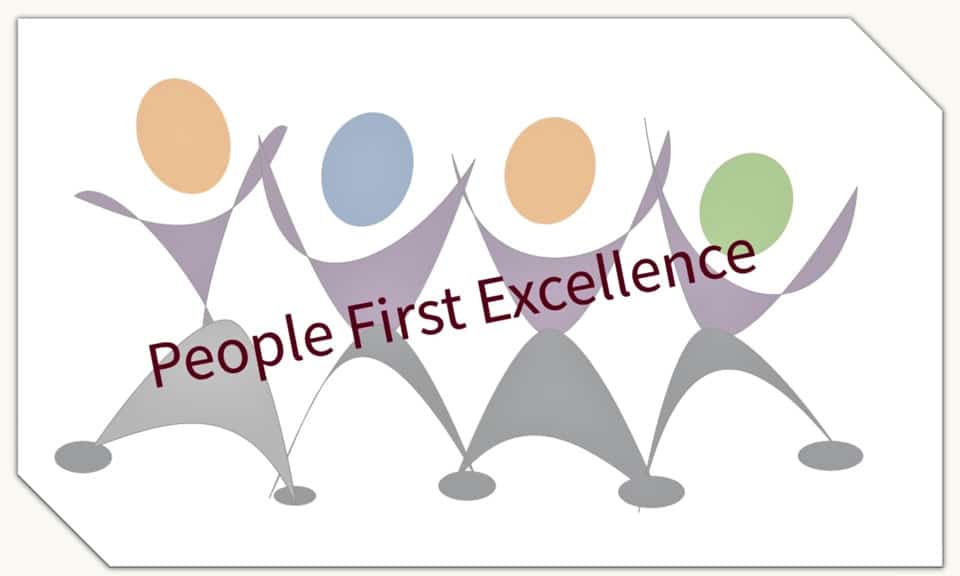People First Excellence: Guiding Actions and Evaluating Outcomes

“It’s easy – All you need is love” –– Lennon & McCartney.
At the height of the Vietnam War, the Beatles sang their iconic song on June 25, 1967, in a television special, a live and international satellite production called “One World.” Their simple message was intended to end the war.
Similarly, “People First” excellence can be easily achieved —all you need is love.
The latest Gallup Q12 Employee Engagement Survey says that only 32% of USA workers are engaged. That percentage is less than half of the 72% across the “best-practice organizations.” The global number is 23%.
TechTarget defines employee engagement as “the emotional and professional connection employees feel toward their organization, colleagues, and work,” and, “A worker’s perceptions about his or her journey through all the touchpoints at a particular company, starting with job candidacy through to the exit from the company, is defined as Employee Experience. The company’s physical workspace, culture, and technology are all important components of the employee experience, which is often abbreviated as EX.”
Employee experience is the foundational pillar on which employee engagement stands. Negative or unsatisfactory experiences can lead to a decline in engagement. Enterprise leaders are well advised to pay attention to people’s experiences to get outstanding engagement.
Why do engagement and experience matter? The benefits are well-documented—low turnover, less stressed employees, reduced burnout and absenteeism, increased productivity, and more. The outcome for the enterprise is increased revenues and satisfied customers.
Leaders can exponentially improve people’s experience in their organizations by putting people first, being role models, empowering, providing psychologically safe workplaces that foster creativity and learning, giving flexibility for when and where their employees work, and helping them lead a balanced life.
People First
“Leaders who lead purposeful organizations are those who put people first. No, it’s not a cliché when they actually do it. It means they set clear expectations, provide adequate resources, coach for success, and evaluate for results.” – John Baldoni
When your employees know they come first, the feeling of belonging increases.
You can execute the “People First” principle in many ways in your organization.
Start with giving them attention. I am a big proponent of Managing by Wandering Around (MBWA). Find opportunities to connect with the people informally. Every manager should make themselves approachable and available to their teams.
Be sure to appreciate the contribution made by the teams. A Forbes article cites a study by The O.C. Tanner Institute and HealthStream, which showed that “lack of appreciation” was cited as the main reason by 79% of employees who left their organizations. In the same study, most employees whose morale was high credited their managers with recognizing their work.
Empower the people to do their jobs with autonomy. When they know they are trusted and are essential to achieving the organization’s goals, it increases their self-esteem and their job satisfaction.
The book, “Leadership Lessons with the Beatles,” says,
“Your team has aspirations. Be their champion. Empower them to express themselves. When you see something that is not aligned with your original thinking, don’t discredit it. Develop a habit of asking, ‘Can you tell me more?’ which is an excellent way to show you care. You show your love by listening actively and being genuine. There will be times when you see unacceptable performance or behaviors. Don’t wait to talk about it. Give constructive feedback for course correction and coach them to do better.”
Make the workplace a psychologically safe place. Amy Edmondson, a Harvard University professor, defines team psychological safety as “a shared belief held by members of a team that the team is safe for interpersonal risk-taking.” The team members in the organization should feel free to discuss conflicting ideas and feel safe about taking calculated risks and failing.
Organizations need to help their people lead balanced lives. Work cannot be all-consuming such that individuals have no time to spend with their families, loved ones, or personal interests. Comparably, the organization that benchmarks companies lists several that promote a balanced life. Squarespace is one of them, and quoted as saying, “Ensuring work-life balance for Squarespace employees provides them with the space to develop and grow their ideas for themselves personally and professionally.”
The pandemic opened our eyes to the many ways work can be flexible. Working from home allowed employees to make it convenient to work when and where. Hybrid work, where the employees go into the office for a couple of days and work from home for the rest of the week, is here to stay. There are jobs where people must be present physically. Offering flexibility can promote employee satisfaction for jobs where it is possible.
An organization’s leadership models the behavior, sets the pace, inspires people, leads by example, exerts positive influence, and guides the people with optimism and courage. Outstanding leadership can grow and sustain delighted employees.
Measuring Employee Experience
Several metrics can help measure and improve employee experience.
- Employee Net Promoter Score: eNPS
This metric is similar to the Net Promoter Score (NPS) used to measure customer experience. You ask the employees to rate the organization on a scale of zero (highly unlikely) to ten (highly likely) in answering the question, “Would you recommend the company as a place of employment?”The responses are classified into three categories—Promoters (those who chose 9 or 10), Neutrals (who chose seven or eight), and Detractors (who chose zero to six).
You calculate eNPS by subtracting the number of detractors from the number of promoters and dividing the answer by the number of respondents.
eNPS questions should be followed by asking the respondents to explain their scores.
Once you have the score, follow it up with action. Have a program to identify root causes behind the neutral and detractor responses and fix them. Any survey result should be shared with the respondents and what you will do about it. The impact of the actions can be measured by making the eNPS survey quarterly.
A blog by CustomerGauge, which provides software to measure account experience software, calls out HubSpot, Salesforce, and Adobe as examples of companies that have high eNPS.
- Employee Satisfaction Level
Surveys can be used to gauge satisfaction levels qualitatively. These surveys should be created with care, not too many questions, but enough to understand the metric. They also need to be timely for a specific employee. For example, the question about onboarding experience should be asked soon after an employee is onboarded in a spot survey.Typical questions might include:
– Do you have autonomy in your job?
– How often do you discuss your aspirations with your supervisor?
– Do you feel you have flexibility in when you work and where you work?
– Do you feel the organization cares about the balance between your work and personal time?
– Do you feel you have the opportunity to learn and grow in your career?In my CEOWORLD magazine article, Leadership success requires the opposite of I Me Mine, I listed a few more items for an employee survey:
– I can bring up difficult questions and not be adversely affected.
– My failures are viewed as learning experiences, and I am comfortable accepting and reporting my mistakes.
– I am comfortable taking calculated risks in approaching a problem.
– I am comfortable asking for help when needed to do my job.
– My teammates are supportive.
– I can be myself, and diversity is valued.
– I get feedback on how I am doing in my position regularly.As with all surveys, the aggregated results should be shared with the employees, and concrete actions must be taken to address the root causes of poor satisfaction indicators.
- Retention Rate/Turnover
Satisfied employees tend to stay with the company. A high turnover metric indicates employees are unhappy with their workplace for many reasons.
In the U.S., around 47% is the average turnover rate. About 70% of this turnover is voluntary. It is estimated that replacing a departed employee costs an organization twice that employee’s salary.
A 2019 meta-analysis of 339 independent studies of more than a million employees across diverse industries by Gallup by the London School of Economics found employee satisfaction has a substantial negative correlation with staff turnover.
Exit interviews can help understand the causes of turnovers. Taking action based on the findings can help improve people’s satisfaction. - Absenteeism
Employees miss work for several reasons, such as caregiving issues, mental and physical illness, and job dissatisfaction and stress. While approved absences and occasional unplanned absences cannot be avoided, chronic absenteeism is of concern. It affects productivity and the morale of other employees.Labor Force Statistics from the Current Population Survey by The Bureau of Labor Statistics indicates the 2022 absence rate was 3.6%. A rate of 1.5% is considered unavoidable and is a benchmark. According to the National Institute of Mental Health, depression is the leading cause of workplace absenteeism, and a study in 2010 found its economic impact to be over 200 billion dollars per year.
Addressing absenteeism can improve productivity substantially. Measuring it is easy with current enterprise tools. It is critical to review this metric regularly and take appropriate actions such as addressing health and safety issues, providing support for mental health, offering flexibility in working, and ensuring inclusiveness in the workplace.
- Customer Satisfaction
Is customer satisfaction an indicator of employee satisfaction? Absolutely. Happy employees create happy customers. Customer satisfaction metrics are well-known.In the Harvard Business Review article, The Key to Happy Customers? Happy Employees, the authors describe a study in which they analyzed the combined data from Glassdoor employee reviews and American Customer Satisfaction Index (ACSI) ratings, which records the opinions of 300,000 U.S. customers on products and services. They write, “We found that each one-star improvement in a company’s Glassdoor rating corresponds to a 1.3-point (out of 100) improvement in customer satisfaction scores — a statistically significant impact, which was more than twice as large in industries where employees interact closely and frequently with customers.”
The article has a powerful message for leaders: “If you want to build a customer-first strategy, building high employee morale is a necessary (though not sufficient) precondition.”
Investing in People is Good for Business
In his book “Excellence Now: Extreme Humanism,” Tom Peters, whom I admire for his message, “People First,” says,
“Take care of people—train them and treat them with kindness and respect and help them prepare for tomorrow. Insist that every employee commit to encouraging growth and caring for their mates. This goes double—or triple—in today’s troubled times. The goal is Extreme Employee Engagement (E-cubed). The bottom line is to make excellence the norm in all people matters. (The “bottom line” is also that this is the best way to grow and the best spur to profitability.)”
Investing in people leads to excellent employee experience, which is good for business.
Written by Shantha Mohan Ph.D.
Have you read?
Ranked: The World’s Most Powerful Countries For 2023.
Ranked: Countries with the highest share of women in parliament.
The World’s Largest Gold Producing Countries, 2023.
Ranked: The World’s Most Influential Countries, 2023.
Ranked: World’s Most Forward-Thinking Countries, 2023.
Add CEOWORLD magazine to your Google News feed.
Follow CEOWORLD magazine headlines on: Google News, LinkedIn, Twitter, and Facebook.
This report/news/ranking/statistics has been prepared only for general guidance on matters of interest and does not constitute professional advice. You should not act upon the information contained in this publication without obtaining specific professional advice. No representation or warranty (express or implied) is given as to the accuracy or completeness of the information contained in this publication, and, to the extent permitted by law, CEOWORLD magazine does not accept or assume any liability, responsibility or duty of care for any consequences of you or anyone else acting, or refraining to act, in reliance on the information contained in this publication or for any decision based on it.
Copyright 2024 The CEOWORLD magazine. All rights reserved. This material (and any extract from it) must not be copied, redistributed or placed on any website, without CEOWORLD magazine' prior written consent. For media queries, please contact: info@ceoworld.biz
SUBSCRIBE NEWSLETTER








